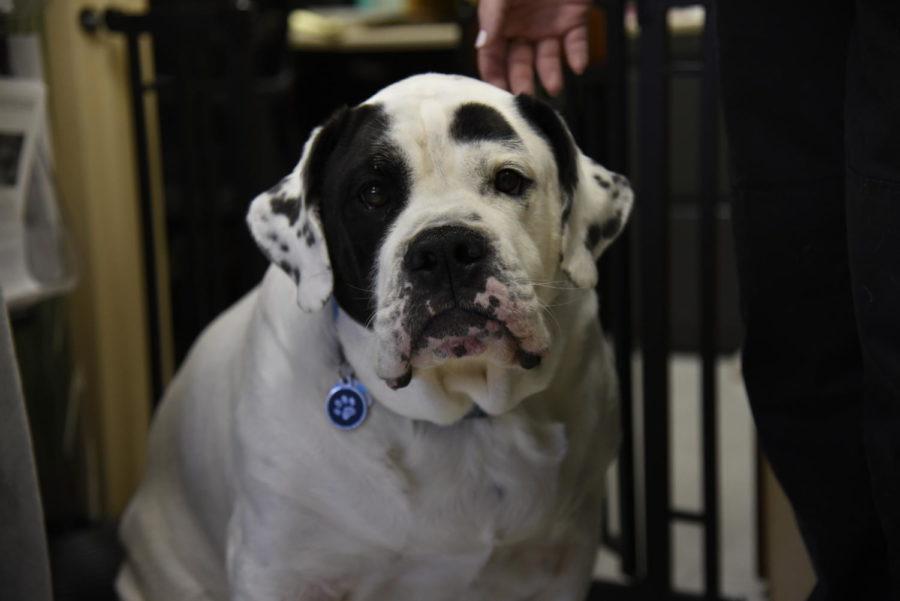National pit bull day raises awareness about pit bulls
Caitlin Yamada/ Iowa State Daily
Beau, an American bulldog owned by Ron Edwards, director of the Ames Animal Shelter.
October 24, 2019
Oct. 26 is National Pit Bull Awareness Day. The day was created in 2007 to help promote truths about the nature of the dog breed and dispel harmful myths. However, the holiday is not always viewed in a positive light.
“We actually don’t acknowledge the day and don’t think it’s actually a positive thing, because if you think about any other awareness day, it’s usually for something negative,” said Stephanie Filer, director of development at the Animal Rescue League of Iowa (ARL) “It’s bullying awareness, mental health awareness, breast cancer awareness. It’s always something that’s like, you need to be aware because it’s impacting people in a negative way. So I don’t personally, and as an organization, we don’t feel that there needs to be an awareness for a certain kind of breed.”
The history of the pit bull breed is a long one, but understanding the history may help people understand where this stigmatization has come from.
Here is some of that history according to nationaltoday.com, love-a-bull.org and Filer:
Pit bulls were originally developed in England in the early 1800s from crossing a bulldog and a terrier. The breed was intended for rodent extermination and dogfighting, which was a popular form of entertainment at the time.
The British Parliament enacted the Cruelty to Animals Act in 1835, which prohibited bull baiting among other practices. “Ratting” became the spectacle of choice, pitting dogs against rats to see which dog could kill the most rats in the shortest amount of time.
When pit bulls were introduced to America, they became known as “working-class companions.” The breed became “America’s Dog” and served as mascots for World War I and World War II. Sgt. Stubby has been called the most decorated war dog of WWI and is the only dog to be nominated for rank and promoted to sergeant through combat.
Dogfighting was made illegal in all 50 states through the 1976 Animal Welfare Act. However, the 1980s saw a resurgence of dogfighting, and pit bulls were increasingly bred for underground fights. Profit was the main concern for the breeders, not the dogs’ temperament or well-being, and this led to pit bulls becoming associated with crime and poverty.
The media has only added to the stereotypes, portraying pit bulls as “killers” and a danger to the public.
“How we talk about pit bulls in the context of them being dogs is so important, because really, the dogs have gotten to this place because, in large part, of the role the media has played,” Filer said. “I can tell you so many times when I’ve had reporters call me about listening to the police scanner, and they hear about an awful dog bite that comes in; they’ll call and the first question out of their mouth is ‘what kind of dog was it?’ And if I say anything but pit bull, they don’t do the story. […] So then from a public perspective, the reporting is unfairly skewed. They’re only hearing about pit bull bites.”
This media attention caused many cities to enact breed-specific legislation (BSL), which generally bans or restricts multiple breeds within a city, according to Filer.
“There are still some cities in the U.S. or counties that have an old approach to managing public safety when it comes to dogs,” Filer said. “The approach that was created in the ’80s was to try to prevent dog bites by preventing certain breeds. […] Various different breeds have been on it over the years, and even now, some cities have as many as 30 to 40, some cities have a handful, but it tends to change […] on which dogs are targeted. [It’s] not based on science, not backed by any sort of research, just based on emotion and fear.”
Iowa is one of the strictest states for these types of laws, and Filer said the laws were also originally based on race and class fears, focusing more on the people who owned the dogs and not the dogs themselves. There have been many significant changes over the years for BSL.
“The best practice that more and more cities continue to move towards are breed-neutral approaches, which basically means that they regulate and restrict dogs and dog owners based on a dog’s behavior or an owner’s behavior, not based on a dog’s appearance,” Filer said.
Michael Vick, a former American football quarterback and co-conspirator in a dog-fighting ring, had his kennels raided in 2007. The media coverage on the recovery story of those dogs, mostly pit bulls, helped shed a much more positive light on the breed for the public, since almost all of the dogs were able to be re-homed or put into foster homes.
National Pit Bull Awareness Day may need to be given a new name of “Love Your Dog Day,” but whether one owns a pit bull or any other breed, it is important to promote overall responsible dog ownership.
“It’s just another thing to put in the news about pit bulls,” Filer said. “And positive or not, the best thing that we can do for these dogs is to talk about them as dogs and not about something special or different.”







